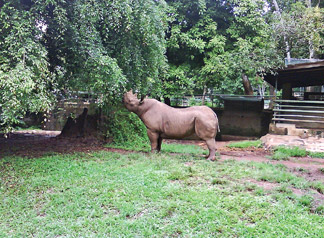Black rhino conservation, a priority at Zoological Gardens
by Dhaneshi Yatawara
 |
|
Dr. Jagath Jayasekera |
To many a zoo is a place they could enjoy seeing animals from all
parts of the world. It is amusing to see such a variety of animals in
one place. A zoo is a gene bank with a collection of fauna including
critically endangered, endangered and threatened species of the world.
Every animal is an asset not only to a particular country but to the
entire world. The Dehiwala zoo is one such place with an ecologically
valuable collection of animals.
The zoo shoulders a major responsibility in conserving and preserving
animals. Among the
critically endangered animals orangutan and rhinoceros top the list.
With the birth of the orangutan baby over a year ago the conservation
efforts of the zoo and its officials became internationally recognised.
The zoo authorities pay more attention to critically endangered
species such as the black rhinoceros.
The black rhinoceros tops the world’s list of critically endangered
species, according to the Red Data List. The black rhino inhabits the
African region, primarily in grasslands, Savannah and tropical bush
lands.
The National Zoological Gardens has two black Rhinoceros, a male and
a female. Sri Lanka received them under an Animal Exchange Program with
Japan in June, 2007.
The two Rhinoceros were from Nagoya and Hiroshima zoos. Sri Lanka
presented two elephants, Kosala and Anula.
The zoo authorities named the Rhinos Kosala and Anula. Due to its
critically endangered status Rhinos are rarely exchanged by countries
and rigid rules and regulations are imposed.
 |
| The current enclosure |
 |
| Animal nursery under
construction |
 |
| New rhino enclosure
under construction |
This exchange program was on two notable animal species that is
listed in ‘Convention on International Trade in Endangered Species of
Wild Fauna and Flora’ (CITES).
In imports and exports in these exchange programs, the Scientific
Authority of the exporting country must make a non-detriment finding,
assuring that export of an animal will not adversely affect the wild
population.
According to the African Rhino Specialist Group at present
approximately 4,240 black rhinos inhabit on the earth.
Thus, Kosala and Anula are valuable among their highly threatened
family members. Understanding the value of these rare species the
Dehiwala National Zoological Gardens are preparing for ex-situ
conservation of the Black Rhinoceros. “ Having these two animals it is
the responsibility of a Zoological Garden to be concerned about
conserving such animals. In one hand we are trying to fulfil a global
responsibility and in the same time it elevates the level of the zoo,”
said National Zoological Gardens Department Director Bashwara Senanka
Gunaratne.
The Department, which comes under the Ministry of Economic
Development, conducts a series of development activities in the zoo to
meet international standards. Upgrading the animal enclosures, is one
such measure.
The zoo is upgrading the rhino enclosure at a cost of Rs. 17 million
to suit the animal and the necessary conservation activities.
“Kosala is now 11 years and Anula is 13. They are grown up animals,”
said Veterinarian of the Zoological Gardens Jagath Jayasekara explaining
that they are at the ideal age to produce an offspring. Birth of a baby
black rhino would be a great achievement in the world conservation
efforts.
The Dehiwala zoo will be recognised for the contribution. The birth
of the orangutan baby, brought international fame and support to Sri
Lanka.
The black rhinoceros population has been severely hit by well
organised, poachers, specially in South Africa, according to the
International Rhino Foundation and according to the African Rhino
Specialist Group.
Gestation of Black Rhinos is approximately 15-16 months, and a mother
rhino can give birth to every two and a half to three years. Females
reach sexual maturity between four and seven years of age; males mature
between 7 and 10 years of age.
The real problem lies with the natural behaviour of the rhinos.
The female rhino becomes very aggressive after mating. “In the wild
the male animal has enough space and they know the places to escape.
But within an enclosure these attacks can be life threatening if the
animal is not provided with adequate safe enclosures,” said Dr.
Jayasekara. “These situations are not favourable for the animal and the
mating won’t be a success,” the veterinarian said. As such the Rhino
enclosure is already expanded and now is in the final phase.
“The new structure will also have specially designed dens that will
allow veterinarians to easily examine the animal and treat them, he
said. “It is mostly done by checking its hormonal level changes by
examining the faecal matter,” the vet explained.
The zoo is building a three-storyed building at the new Animal
Nursery Hospital within the zoo premises at a cost of Rs. 32.8 million. |

